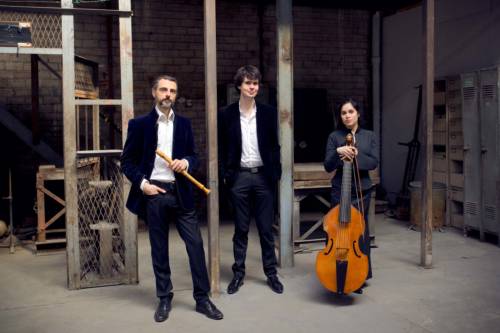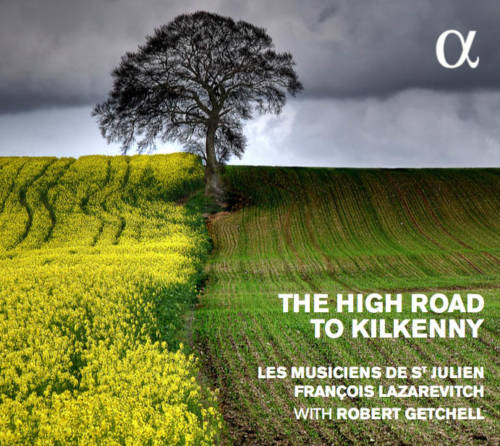JS Bach, Sonates pour flûte ⎜réédition
Tracklisting

 Choc de Classica
Choc de Classica De Volkskrant 5/5
De Volkskrant 5/5
Alpha productions • Alpha 490 • ISBN 3760014194900 • 1 CD • 1 h 23
- Sonate en si mineur – Andante (7:18)
- Sonate en si mineur – Largo e dolce (3:27)
- Sonate en si mineur – Presto (part 1) (1:37)
- Sonate en si mineur – Presto (part 2) (4:17)
- Sonate en mi mineur – Adagio ma non tanto (2:19)
- Sonate en mi mineur – Allegro (2:46)
- Sonate en mi mineur – Andante (3:41)
- Sonate en mi mineur – Allegro (4:56)
- Sonate en mi majeur – Adagio ma non tanto (2:19)
- Sonate en mi majeur – Allegro (3:14)
- Sonate en mi majeur – Siciliana (3:24)
- Sonate en mi majeur – Allegro assai (3:17)
- Partita – Allemande (5:59)
- Partita – Corrente (3:51)
- Partita – Sarabande (4:29)
- Partita – Bourrée angloise (2:55)
- Sonate en la majeur – Vivace (3:55)
- Sonate en la majeur – Largo e dolce (3:09)
- Sonate en la majeur – Allegro (4:13)
Listen to the disc
About

Programme
JS Bach, flute sonatas
Interpreters
François Lazarevitch : flute & direction
Jean Rondeau : harpsichord
Lucile Boulanger : viola da gamba
Thomas Dunford : archlute
Thanks to superlative virtuosity, François Lazarevitch and his musicians take the listener into a whirlwind that leaves his head in the stars.
PHILIPPE VENTURINI – CLASSICA
Press
may 2014
Classica – Choc
Philippe Venturini
Bach takes care of you
Thanks to superlative virtuosity, François Lazarevitch and his musicians take the listener into a whirlwind that leaves his head in the stars. The first bars of the Andante from BWV 1030 raise fears of a virtuoso reading by young people in a hurry. Going tempo, compelling syncopations, impeccable set-up, very straight delivery, impeccable accuracy: such perfection impresses. But as the music unfolds, we understand that this was an attention-grabbing curtain-raiser and not an interpretative focus for the entire program. Very quickly, the repeated eighth notes (G then F) reveal a fluidity of phrasing which owes nothing to mechanics but comes from speech and its punctuation. And in this particularly developed movement, of more than a hundred measures, in which the flute and the harpsichord share a real concert dialogue, Bach took care of the most subtle inflections, using a constantly varied rhythm.
This is one of the strengths of this version which stands at the top of the discography despite very careful Frans Brüggen, Barthold Kuijken and Jed Wentz: going to the bottom of the notes without ever taking the pose of the thinker or adopting a didactic language . François Lazarevitch reveals in his presentation text the secret of this success: the reading of a manuscript by Quantz, kept in the royal library of Copenhagen, rich in lessons on articulation and uneven notes. Obviously, the flautist will not systematically hiccup his melodic line but he shapes it according to a flow which very often approaches spoken language. François Lazarevitch and his accomplices let this music express itself with a disconcerting naturalness.
“Under his hand every piece seemed like a real speech,” Forkel wrote of Bach. The Musicians of Saint-Julien have not forgotten him.
may 2014
Diapason – 4 diapasons
Philippe Ramin
François Lazarevitch is best known on record for his remarkable work around traditional repertoires and his links with scholarly music over the centuries. A bagpipe virtuoso, whose sound he manages to inflect with vocal elegance, he is also a master of the traverso. For the sonatas that Bach intended for this instrument, he surrounded himself with some of the most charismatic and imaginative performers and the new generation of Parisian Baroque. His reading is nourished by a particular approach to the concepts of inequality and the construction of phrasing. Few instrumentalists have this flexibility and eloquence in the expressive treatment of rhythm. He adds the viol in the Sonata in E major, the viol and the archlute in E minor: a pleasant decorum, but which runs the risk of masking the subtlety of the counterpoint in the initial movements. Lucile Boulanger adapts her playing with remarkable mastery and a sense of counterpoint (precisely) which does full justice to the marvelous Sicilienne (E major) and the energy of the rapid movements. We remain impressed by the organization of the flautist’s ideas. He doesn’t have ten a minute, but simply the right one, presented with the authority that anticipation of the speech, its color and its right weight allows. Not quite on the same wavelength, Jean Rondeau plays a German-type harpsichord from which he knows how to get the most out of the sound. The version of the Partita for solo flute is both full of rigor and life. Lazarevitch creates a sincere fervor that commands admiration.
may 2014
De Volkskrant – 5 étoiles
Guido van Oorschot
One balmy summer night in 1720, J.S. Bach must have thought: how could I collect the smell of honeysuckle and put it to music? On a delicate ostinato motif, he unfolds an ethereal flute melody. For the Andante alone of the intoxicating Sonata for flute and basso continuo in E minor Bach deserves his worldwide fame. It must be said that this genius composer must have foreseen the arrival of a baroque ensemble called the Musiciens de Saint-Julien. And that its conductor, François Lazarevitch, would respond magically to Bach’s chamber music for transverse flute. Four sonatas and the famous Partita: superbly played and accompanied with refinement on harpsichord, viola da gamba and lute.






